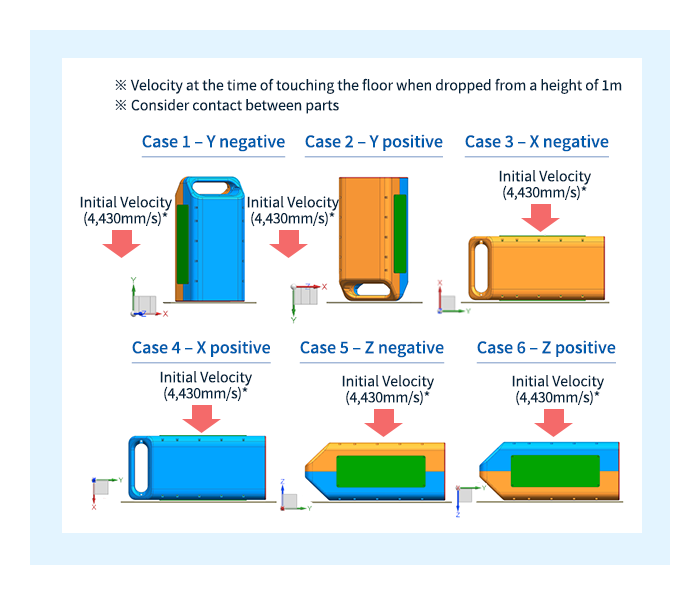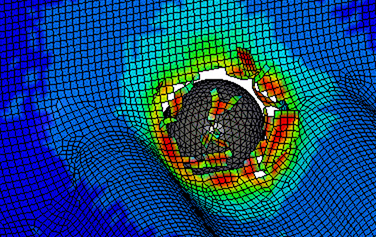- TOP
- 技術サポート
- Examples of CAE results
- Drop test simulation base on UN R136 : Swappable Battery Pack

Impact analysis
Drop test simulation base on UN R136 : Swappable Battery Pack
Summary
- This section introduces examples of XYRON™'s drop test simulations used for battery cases and cell holders.
- After verified by 1m drop test simulation based on UN R136, the molded product passed the actual drop test.
Introduction
Since there were concerns about fracture when the case was molded with resin, we conducted drop and flow analysis while changing the shape to confirm that there were no performance or moldability problems before conducting the test.
One method of verifying the safety and evaluating the durability of lithium-ion batteries is through a drop test. This test involves dropping the battery from a specified height in a predetermined manner (designating the angle and parts), onto a pre-determined type of floor material to measure its impact resistance.
Here, we present a case study of a drop test simulation that adopted the standards of UN R136, specifically for XYRON, which is used in actual battery cases and cell holders.

XYRON™ used in battery cases and cell holders
Purpose
The durability of the battery pack against drop impacts and the verification of changes under the condition of being subjected to shock.
Methods
Detailed impact analysis simulation using Asahi Kasei internal know how to achieve as close requirements from battery safety standard (UN R136).

Drop test simulation conditions
Results
The drop test complies with AIS-156 Annex8C "Mechanical drop test for removable REESS."
In addition, the protection rating of the body (enclosure) is specified as IPXXB, and if cracks occur, the crack diameter must be less than 12 mm.
Below we show the actual simulation results.

Simulation results for Case 1
The drop analysis predicted that cracks would only occur when dropped in the X and Y directions. However, the crack size was less than 10mm in either direction, which confirmed that there were no problems and XYRON™ battery case was successfully certified.
Drop test simulation results
| Analysis case | Material | Direction | Crack size(mm) *** |
Criteria | Evaluation |
|---|---|---|---|---|---|
| Case 1 | Xyron 443Z |
Y-Negative | 3.23 | Crack size less than 10 min | OK |
| Case 2 | Y-Positive | 1.31 | |||
| Case 3 | X-Negative | 0.99 | |||
| Case 4 | X-Positive | 0.88 | |||
| Case 5 | Z-Negative | 0.00 | |||
| Case 6 | Z-Positive | 0.00 |
<Other considerations>
For more information about CAE, please contact us.
Inquiries








